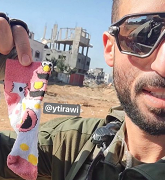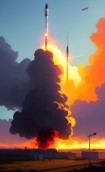|
Well that makes sense, I'd just solve the problem by only throwing the good grenades, not the duds.
|
|
|
|

|
| # ? Jun 5, 2024 06:14 |
|
A.o.D. posted:It was based on percentage of throws that made it into the target area. When I went through the course to get expert 100% of your throws had to land in the target area on the first try. I (army) did what mlmp described - throw from foxhole, throw into mortar pit, throw from prone, cook off two seconds and throw into bunker, etc. Importantly, we used training dummy grenade bodies instead of live grenades for that range. It’s a separate day from live grenades and unlike the live grenades, you don’t actually have to pass it to pass basic.
|
|
|
|
Vincent Van Goatse posted:Be glad the WW2 Army's attempt to develop a grenade that could be thrown like a baseball didn't work out, I guess. I think my biggest takeaway from this wiki is, there is a secondary collectors market for live 60 year old grenades?!? 
|
|
|
|
kill me now posted:I think my biggest takeaway from this wiki is, there is a secondary collectors market for live 60 year old grenades?!? The grenades only blow up in value with age
|
|
|
|
I'm seeing reports that Russians/Wagner are making gains in Bakhmut, taking the central admin building in the past 24-36 hours. How significant is that in reality? Is it a _big_ deal or do the Ukrainian military actually care? It seems to me that the Russians are taking huge losses for gains of minimal value and the UA is bleeding them to death and forcing them to waste lots of resources that might otherwise be better used when the spring offensive starts?
|
|
|
|
Cimber posted:I'm seeing reports that Russians/Wagner are making gains in Bakhmut, taking the central admin building in the past 24-36 hours. How significant is that in reality? Is it a _big_ deal or do the Ukrainian military actually care? It seems to me that the Russians are taking huge losses for gains of minimal value and the UA is bleeding them to death and forcing them to waste lots of resources that might otherwise be better used when the spring offensive starts? Lmao - "gains" is a strong word. They've been fighting over Bakhmut for months without any major changes in control.
|
|
|
|
I do think it's fair to say that they have now made some gains, and that the Ukrainian defense lines seem to have retreated from near the river to the vicinity of the railroad. As to it being significant... That's about the distance of a mile. In months of fighting. And there are new defensive lines behind the current ones. So no.
|
|
|
|
Think of Bahkmut like Verdun. The significance comes from whatever attritional losses have been inflicted, not on how much territory is won or lost. And we can only guesstimate as to how the war of numbers is going.
|
|
|
|
There was a pretty grisly series of videos on /r combatfootage last night showing the aftermath of the Ukrainians dropping explosives off drones into a series of Russian trenches. The final shot was just a drone flying over this long trench that was absolutely filled with dead Russian soldiers. It really does lend credence to the numbers the Ukrainians claim Russia is losing in this push.
|
|
|
|
Vengarr posted:Think of Bahkmut like Verdun. The significance comes from whatever attritional losses have been inflicted, not on how much territory is won or lost. And we can only guesstimate as to how the war of numbers is going. That Ukraine is continuing to attrit the Russians in Bahkmut tells me the Russians are faring far worse than their opponents. Everything I've seen says that UA is smart enough they'd have withdrawn if they weren't making every casualty count.
|
|
|
|
Tuna-Fish posted:I do think it's fair to say that they have now made some gains, and that the Ukrainian defense lines seem to have retreated from near the river to the vicinity of the railroad. The sheer amount of bodies Russia has thrown into this makes it far from a gain, even if they captured land. The cost is not aligned with the advances they've made.
|
|
|
|
Godholio posted:That Ukraine is continuing to attrit the Russians in Bahkmut tells me the Russians are faring far worse than their opponents. Everything I've seen says that UA is smart enough they'd have withdrawn if they weren't making every casualty count. In the latest War on the Rocks podcast yesterday Kofman said he doesn't think the attrition has been especially favorable for Ukraine in Bakhmut for the last several months. Apparently the first couple months in Bakhmut were a good ratio for UA but it got pretty bad after that. Ukraine changed strategies after the huge success at Kherson from a defense in depth to a more static hold-every-inch approach and there's supposedly a lot of debate about if this was a good call or not. Post-mobilization the manpower advantage is in Russia's hands so it's been harder to make the trade count as much as it did early on.
|
|
|
Cimber posted:I'm seeing reports that Russians/Wagner are making gains in Bakhmut, taking the central admin building in the past 24-36 hours. How significant is that in reality? Is it a _big_ deal or do the Ukrainian military actually care? It seems to me that the Russians are taking huge losses for gains of minimal value and the UA is bleeding them to death and forcing them to waste lots of resources that might otherwise be better used when the spring offensive starts? https://twitter.com/War_Mapper/status/1641961313793441792
|
|
|
|
|
CommieGIR posted:The sheer amount of bodies Russia has thrown into this makes it far from a gain, even if they captured land. These are loss levels unseen in combat since at least Korea.
|
|
|
|
bulletsponge13 posted:Traditionally, you always use the most casualty producing weapon first, provided situation dictates. You don't use a pistol when you have a grenade, you don't use a rifle when you have an MG type thing. It's efficient, and it produces a psychological effect. I didn't realise they would take out the coax, hopefully they don't on CR2 as it's a chain gun and isn't redeployable. Honestly get it for the most casualty producing weapon but with CR2 as that's my area I wouldn't be engaging that close with HESH, on such a pinpoint target for reason I won't go into it ain't worth it, better to reverse off and engage a few hundred meters back, now the coax with the CR2a increased depression ability could have absolutely raked the poo poo out of them and there are minimum las return drills for those engagements. I just hope they employ the CR2 well, I know they got great instruction while they were with us.
|
|
|
|
bulletsponge13 posted:These are loss levels unseen in combat since at least Korea. Iran-Iraq War? It also had some pretty hellish large-scale infantry focused operations.
|
|
|
|
OctaMurk posted:The grenades only blow up in value with age 
|
|
|
|
https://twitter.com/USEmbassyPrague/status/1643166727948075011 Well played.
|
|
|
|
Fearless posted:Iran-Iraq War? It also had some pretty hellish large-scale infantry focused operations. That's fair, and slipped my mind. My knowledge on that conflict is fairly limited. I think I was also applying a needless time frame comparison- this war is just over a year- my crap memory of Iraq-Iran was casualties seriously ramped up a few years in. It just blows my mind seeing the numbers. I was under the false assumption that a near peer conflict wouldn't have casualties like this, because no country would be willing to go back to throwing 2k to gain 2 meters.
|
|
|
|
The Battle of Khorramshahr comes to mind from the Iran Iraq war, but Bakhmut might have produced more casualties by now
|
|
|
|
Anonymous Zebra posted:There was a pretty grisly series of videos on /r combatfootage last night showing the aftermath of the Ukrainians dropping explosives off drones into a series of Russian trenches. The final shot was just a drone flying over this long trench that was absolutely filled with dead Russian soldiers. It really does lend credence to the numbers the Ukrainians claim Russia is losing in this push. Even if you go with the UK MoD estimates, the numbers are staggering. 220k+ casualties would be about 145k wounded and 75k killed.
|
|
|
|
Cimber posted:I'm seeing reports that Russians/Wagner are making gains in Bakhmut, taking the central admin building in the past 24-36 hours. How significant is that in reality? Is it a _big_ deal or do the Ukrainian military actually care? It seems to me that the Russians are taking huge losses for gains of minimal value and the UA is bleeding them to death and forcing them to waste lots of resources that might otherwise be better used when the spring offensive starts? That’s the military side, but military considerations aren’t the only important thing here. Bakhmut has become politically symbolic for both sides and taking/losing it would have significant morale and political implications. Losing Bakhmut would certainly be a blow to Ukrainian morale and likewise give Russian morale a boost. It could change how NATO or China view each side’s prospects for victory; it could make Zhelensky’s government less popular etc etc. Similarly, not giving Russia that victory leaves Russia with having accomplished basically nothing in their very costly winter offensive. That’s a big morale win, even if it’s not a decisive moment in the war militarily. The view from the Ukrainian side is also ‘any ground we give up is ground we will have to take back later’ and generally holding ground is easier than retaking ground. Ukraine traded space for time earlier in the war, but that strategy seems to be shifting the other way towards ‘fight for every inch.’ Ukraine’s objectives in the battle are more complex than simple ‘inflicted the most favorable ratio of casualties on Russia’- if that were their only goal, they would probably be better off withdrawing to more favorable defensive ground behind Bakhmut.
|
|
|
|
Vincent Van Goatse posted:Be glad the WW2 Army's attempt to develop a grenade that could be thrown like a baseball didn't work out, I guess. Are there any that resemble a crumpled-up beer can?
|
|
|
|
bulletsponge13 posted:These are loss levels unseen in combat since at least Korea. the Iran Iraq war was pretty deadly too Arab israeli wars were short but sharp and killed a lot of people in a short amount of time And the military casualties in the tigray war are likely underestimated OctaMurk fucked around with this message at 20:11 on Apr 4, 2023 |
|
|
|
Kaiser Schnitzel posted:Strategically/militarily it’s not especially significant except to the extent that holding it may have caused Ukraine to expend resources (manpower, equipment, especially artillery ammunition) that might have better been saved for their upcoming offensive. On the other hand, Russia is also using up a lot of stuff/people there that it won’t have to defend against that offensive. Nobody is going to know if continuing to fight for the city or withdrawing would have been the smarter move for years to come. Knowing that getting drafted meant being dead in Bakhmut mere weeks later also wasn't great for Ukrainian morale tho.
|
|
|
|
hypnophant posted:I (army) did what mlmp described - throw from foxhole, throw into mortar pit, throw from prone, cook off two seconds and throw into bunker, etc. Importantly, we used training dummy grenade bodies instead of live grenades for that range. It’s a separate day from live grenades and unlike the live grenades, you don’t actually have to pass it to pass basic. We did all of our throwing in one day. All of the throws except for the last one were with simunition. The last was was the real deal. Sorry to say that we didn't have any exciting fuckups to regale you with. My unit was boringly competent.
|
|
|
|
One of my most cherished memories is of a very stupid Lt accidentally setting off a practice grenade in his pocket. He was loving around with it, looked a bit worried, then his pocket exploded. The same guy complained about having to carry the GPMG in Helmand, saying there was a risk he "would become combat ineffective". My buddy from the patrol says their boss turned around and just said "I'm prepared to take that risk" 
|
|
|
|
I'm a southpaw and every drat instructor on my basic was right handed. This is not good when training the mechanics of grenades. I even got to try the freaky 'hold grenade upside down' style although I quickly went back to the standard style.
|
|
|
|
I wish I could throw a grenade I will never taste the knowledge of such fruits
|
|
|
|
My grandfather had a hand-grenade incident while training with the Canadian army for WWI:quote:During his basic training at Niagara-On-The-Lake they were taught how to use hand grenades. They were shaped like a small pineapple with a pair of handles that you could squeeze together. The handles were held in place by a pin that penetrated both parts. When the handles came apart, a five-second fuse was activated. In practice you held the handles together with one hand and pulled the pin with the other. When you tossed the grenade, you released the handles and the grenade scattered shrapnel five seconds later.
|
|
|

|
|
|
|
|
Oh gently caress
|
|
|
|
|
I have questions about there being a "pile" of live grenades, but they're probably pretty well answered by it being 1915 or so.
|
|
|
|
mllaneza posted:I have questions about there being a "pile" of live grenades, but they're probably pretty well answered by it being 1915 or so. Yeah, a lot of his training stories were like that. Health and Safety hadn't really been thought through, whatever was fast and convenient was the way to go.
|
|
|
|
mllaneza posted:I have questions about there being a "pile" of live grenades, but they're probably pretty well answered by it being 1915 or so. I have a feeling that it's happened in Ukraine in TYOOL 2023, based on the videos of Russian soldiers unloading anti-personnel mines from trucks by shoving them out the back
|
|
|
|
In every trench video there is a cubby stacked with frags.
|
|
|
|
I kept the ring off one CS grenade I threw and still have it and use it as a key ring.
|
|
|
|
US Senior Defense Official (SDO) brief re: Ukraine today. Intro then excerpts as I choose. Press Briefing: https://www.defense.gov/News/Transcripts/Transcript/Article/3351824/senior-defense-official-holds-a-background-briefing-on-ukraine/ Press Release with PDA (fast from US stocks, $500 milion) and USAI (weeks to months/years contracted from industry, $2.1 billion) https://www.defense.gov/News/Releases/Release/Article/3350958/biden-administration-announces-additional-security-assistance-for-ukraine/ Highlights: -SDO says lines largely static with significant artillery exchanges, but not much maneuver, and aim is to assist Ukraine go on counteroffensive [My note: just in the lasts 24-48 hours, some reports that Bakhmut lines might be moving in Russia's favor, but it's been months to move a matter of single-digit kilometers, and Bakhmut was originally thought to be potentially falling/evacuated a month ago] -Four efforts: 1: Improved layered air defenses; 2: deliver steady flow of artillery rounds, other ammunition, spare parts, and maintenance support; 3: Armor (vehicle) donations; 4: train combined arms combat and maneuver -SDO says US "understands" Ukrainian strategy in holding Bakhmut. Says Ukraine still has forces to pursue next phase of the war. -When asked about US contracting for 122mm (soviet design) vs 155mm, the answer is kind of wishy-washy. Providing ammo for legacy guns, because Ukraine has them, but also there's a clear hunger for ammo amounts that the US and partners cannot sustain only from 155mm, though efforts are underway to increase 155mm production. [But the US has pretty publicly stated in press briefings and talks outside of this one that 155mm (and some other munitions) are not produced at a sufficient rate to meet demands due to prioritizing efficiency over raw production numbers.] I left all the howitzer discussion in, because there's a fair amount of reading between lines, especially when combined with past US statements over the past 6+ months about ordnance production numbers and drawdown of stocks. -SDO does not say Wagner will be replaced or leadership in any domestic danger, just points out that there is squabbling, when asked about it -No firm update on Patriot employment or delivery timeline, Abrams delivery timeline. quote:STAFF: Good afternoon, everyone. Thank you for joining us today for this background call. Joining us today is (inaudible) will be on background today with attribution to "a senior defense official".
|
|
|
|
Kesper North posted:I have a feeling that it's happened in Ukraine in TYOOL 2023, based on the videos of Russian soldiers unloading anti-personnel mines from trucks by shoving them out the back Weren't those anti-tank mines that didn't have their fuses installed?
|
|
|
|

|
| # ? Jun 5, 2024 06:14 |
|
bulletsponge13 posted:In every trench video there is a cubby stacked with frags. Familiar with German stick grenades? The head contains the delay train, with a string running through it attached to a porcelain ball at the bottom of the stick, held in by a screw-off cap. Expect trouble? Stack grenades with the stick facing you, unscrew cap(s), trail string and ball out, huck them out there while holding the ball (or not). Hope for the best! Hope the counter-attack pushes past you.
|
|
|















































